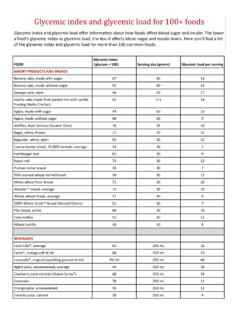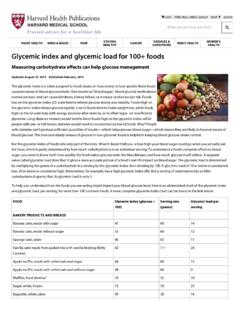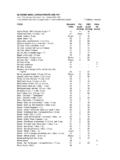Transcription of Fact Sheet: Glycemic Index
1 NWAC Diabetes Self-Management Toolkit for Aboriginal Women - Fact Sheet: Glycemic Index Fact Sheet: Glycemic Index This fact sheet has been put together to help you gain a better understanding of the Glycemic Index . Always consult your Health Care Professional before making any changes to your diabetes management plan. What is the Glycemic Index (GI)? The Glycemic Index (GI) ranks carbohydrates in foods on a scale from 0 to 100 based on how much it raises your blood sugar levels after eating. In other words, the GI is a measure of the effects of carbohydrates on blood sugar levels. The Glycemic Index is based on a scale, what are the scale levels?
2 Low GI= Under 55. Moderate GI = 56 -69. High GI = Greater than 70. What is the Glycemic Index Chart? The Glycemic Index chart contains a list of foods along with a number ranging from 1 to 100. This number shows how much and how quickly your blood sugar will rise with each item. A food item with a high GI will be digested and burn energy faster while raising your level of blood sugar quickly. An item with a low GI will take more time to digest and will slowly raise your blood sugar level. Why was the Glycemic Index created? The GI was developed to help people with diabetes control their blood glucose levels.
3 How can the Glycemic Index help me? The GI can help you select foods for diabetes management. Low GI diets have been shown to improve both glu- cose and lipid levels in people with diabetes (type 1 and type 2). They have benefits for weight control because they help control appetite and delay hunger. Low GI diets also reduce insulin levels and insulin resistance. What are the benefits of using the Glycemic Index ? There are numerous benefits to using the GI in selecting foods to consume, besides how it effects High your blood sugar levels: GI. Low GI diets help people lose and manage weight Over Low GI diets increase the body's sensitivity to insulin 70.
4 Low GI carbs improve diabetes management Low GI carbs reduce the risk of heart disease Low GI carbs improve blood cholesterol levels Medium Low GI carbs reduce hunger and keep you fuller for longer GI Low GI carbs prolong physical endurance 56 to 69 High GI carbs help re-fuel carbohydrate stores after exercise Recent studies from the Harvard School of Public Health indicate that the risks of diseases such as type 2 diabetes and coronary heart disease are strongly related to the GI of the overall diet. Low In 1999, the World Health Organization (WHO) and Food and Agriculture Organization (FAO) rec- GI ommended that people in industrialized countries base their diets on low-GI foods in order to pre- 55and vent the most common diseases of affluence, such as coronary heart disease, diabetes and obesity.
5 Under Talk to your doctor, registered dietitian, diabetes educator or health care professional about the Glycemic Index today. NWAC Diabetes Self-Management Toolkit for Aboriginal Women - Fact Sheet: Glycemic Index Glycemic Index Chart of Common Foods GI numbers may differ by the type of food, its ripeness, processing, the length of storage, cooking methods, and its variety. The numbers provided below should be considered as a guide indicating which category a specific food item is most often rated. Low GI (55 and Under) Medium GI (56 to 69) High GI (70 and Over). Cereals All Bran 51 Cream of Wheat 66 Bran Flakes 74.
6 Bran Buds + Phylum 45 Grape nuts 67 Cheerios 74. Frosted Flakes (3/4c) 55 Life 66 Corn Chex 83. Muesli, natural 54 Nutri-grain 66 Corn Flakes (1c) 83. Oatmeal, old-fashioned 48 Puffed Wheat 67 Raison Bran 72. Special K 54 Shredded Wheat 67 Rice Chex 89. Multigrain Hot Cereal 25 Fruit Loops 69 Total 76. Pan cakes (mix) 67 Rice Krispies 82. Oatmeal, one-minute 66 Pop Tarts 70. Waffles 76. Fruit Apple (med.) 38 Apricots (3 med.) 57 Dates 103. Cherries (10 lg.) 22 Banana 56 Watermelon (1 cup) 72. Grapefruit 25 Cantaloupe 65. Kiwi 52 Papaya 58. Mango 55 Pear 58. Orange 43 Pineapple (2slices) 66. Peach 42 Raisins (1/4c) 64.
7 Plums 39 Fruits, mixed, dry 60. Prunes 39 Fruit Cocktail 55. Grapes, green (1c) 46. Strawberries 40. Common Snack Foods Chocolate Bar 49 Croissant 67 Corn Chips 72. Peanut Crunch Bar, Usana 26 Oatmeal Cookie 57 Donut 76. Popcorn, light microwave 55 Arrowroot Cookie 63 Graham Crackers 74. Pound Cake 54 Potato Chips (14p) 56 Jelly Beans 80. Snickers Bar 41 Power Bars 58 Life Saver 70. Strawberry Jam 51 Shortbread Cookies 64 Pretzels 83. Cashews 22 Wheat Thins 67 Saltine Crackers 74. Peanuts 14 Rye crackers 68 Vanilla Wafers 77. Walnuts 15 Mars bar 68 Rice cakes, plain (3) 82. Oatmeal Cookie (1) 55 Granola bar, chewy 61 Rice crackers 91.
8 Apple Muffin 48 Muffin, Bran 60 Soda crackers 74. M&M's Chocolate, peanut 33 Muffin, Carrot 62 Melba Toast 70. Nutella spread (2oz) 30 Pastries/Pastry 59 Cupcakes 73. Fruit strips 29 Marshmallows 62 Skittles 70. Common Drinks Apple Juice 40 Fanta soft drink (1can) 63 Coca-Cola (1can) 77. Orange Juice 50 Fruit Punch 67 Gatorade (8oz) 78. Grapefruit Juice 48 Orange soft drink (1can) 68 Energy Drinks 136. Tomato Juice 38 Cranberry Juice Cocktail 68. Lemonade, sweetened 54. Chocolate Milk 34. Milk Products Skim Milk 32 Ice cream, vanilla 60 Tofu Frozen Dessert 115. Soy Milk 31. Whole Milk 30. Yogurt, fruit 36.
9 Yogurt, plain 14. Low fat Ice cream 35. NWAC Diabetes Self-Management Toolkit for Aboriginal Women - Fact Sheet: Glycemic Index Fact Sheet: Glycemic Index GI numbers may differ by the type of food, its ripeness, processing, the length of storage, cooking methods, and its variety. The numbers provided below should be considered as a guide indicating which category a specific food item is most often rated as. Low GI (55 and Under) Medium GI (56 to 69) High GI (70 and Over). Vegetables & Beans Carrots, fresh, boiled 49 Corn, sweet 56 Parsnips 97. Peas, fresh, boiled 48 Beets 69 Potato (baked) 93. Broccoli / Cabbage 10 Potato, new 62 Potato (mashed, instant) 86.
10 Lettuce / Mushrooms 10 Potato (French fries) 75. Onions / Red peppers 10 Pumpkin 75. Sweet potato 54 Broad Beans 79. Artichoke / Asparagus 15 Chips 75. Spinach / Tomatoes 15. Zucchini / Cucumber 15. Bean Sprouts 25. Green Beans 38. Chick Peas (can) 42. Kidney Beans (can) 52. Baked Beans 48. Breads Pumpernickel 49 Croissant 67 Bagel, plain 72. Sourdough 54 Rye Bread 64 French Baguette 95. English Muffin, whole grain 45 Wheat Bread 68 Dark Rye 76. Multigrain Breads 45 Blueberry Muffin 59 White Bread 70. Wholegrain Bread 40 Pita Bread 57 Kaiser Roll 73. Hamburger Bun 61 White Rolls 73. Hotdog Buns 62 Bread stuffing, Paxo 74.














